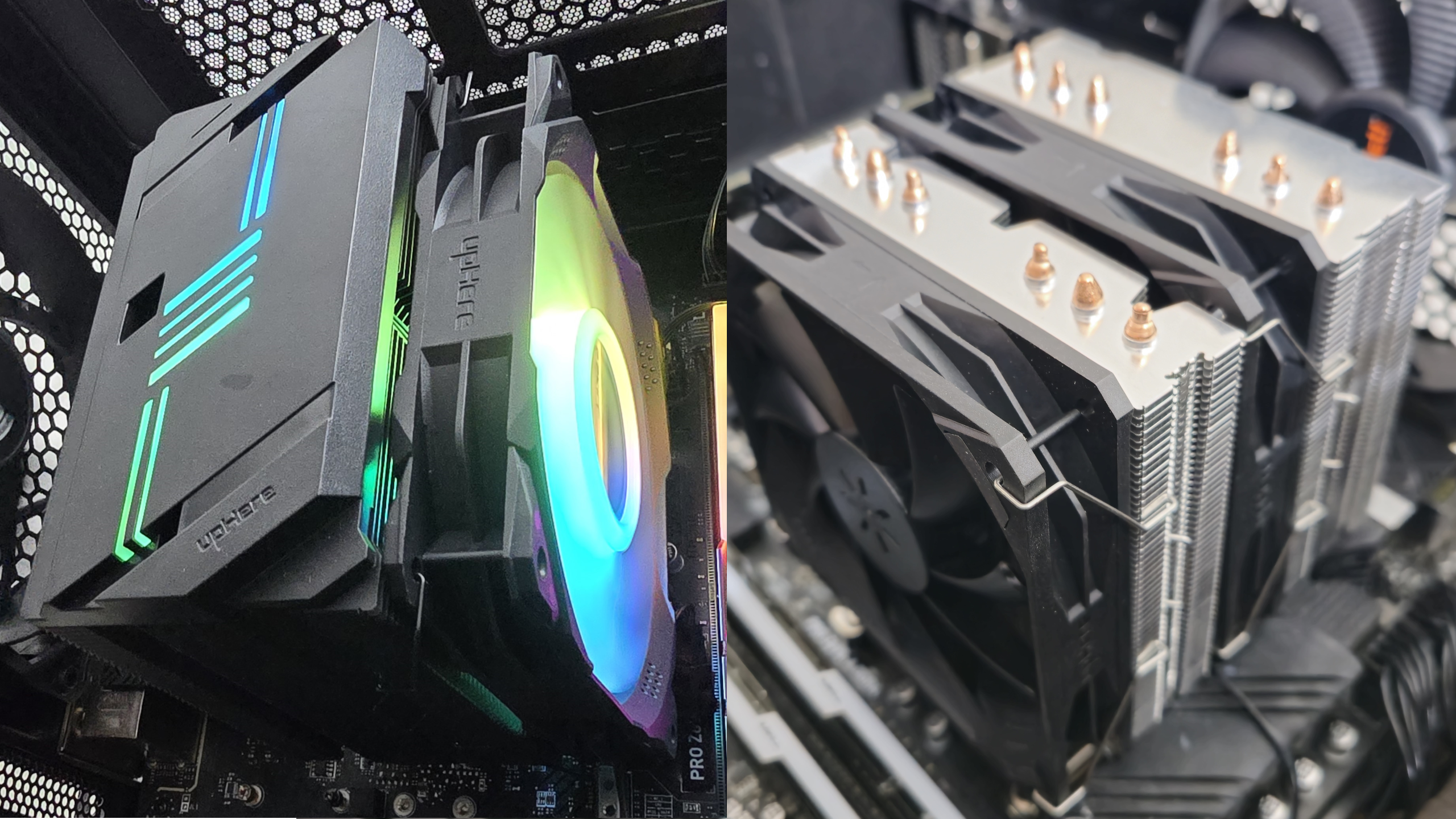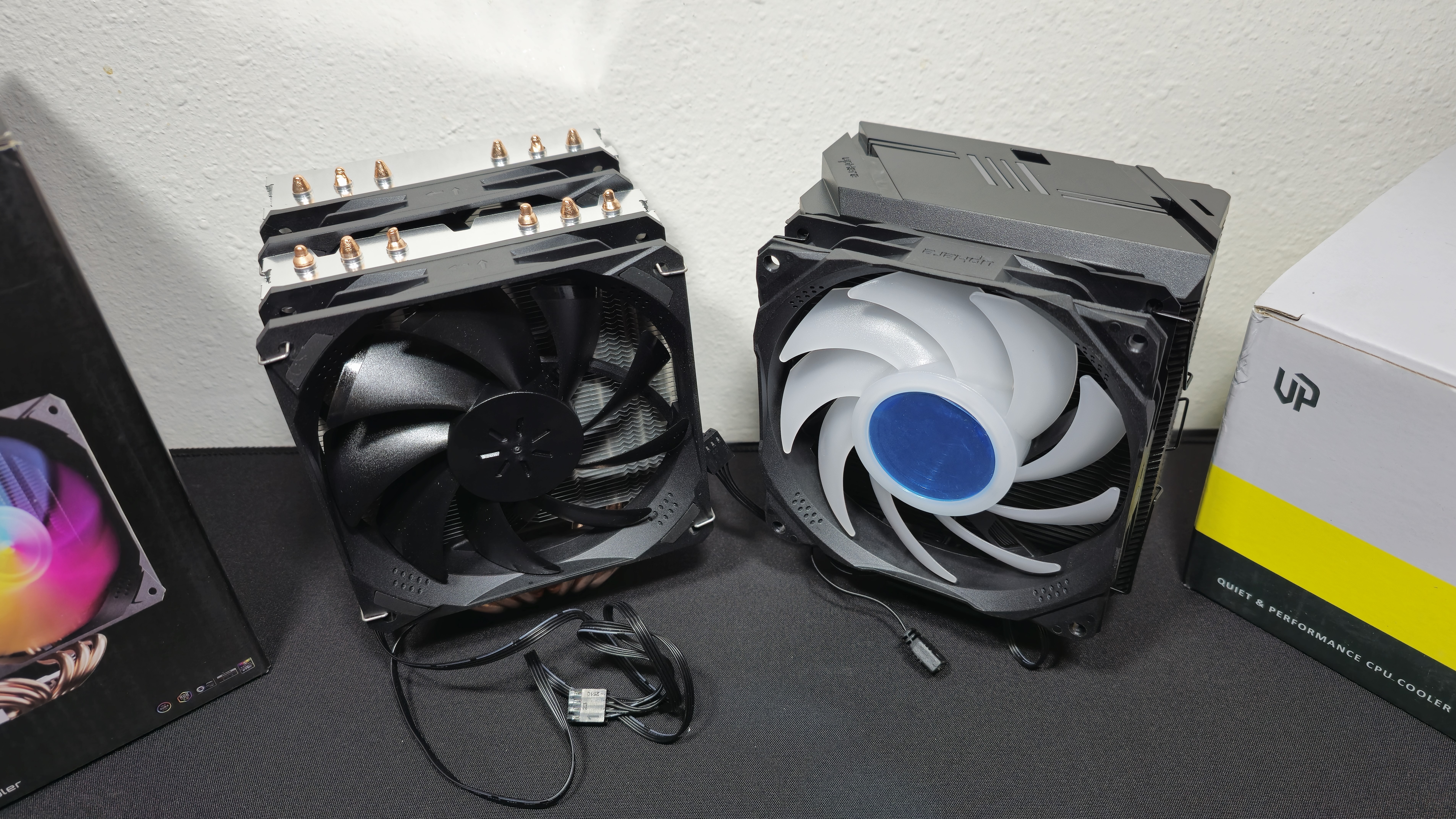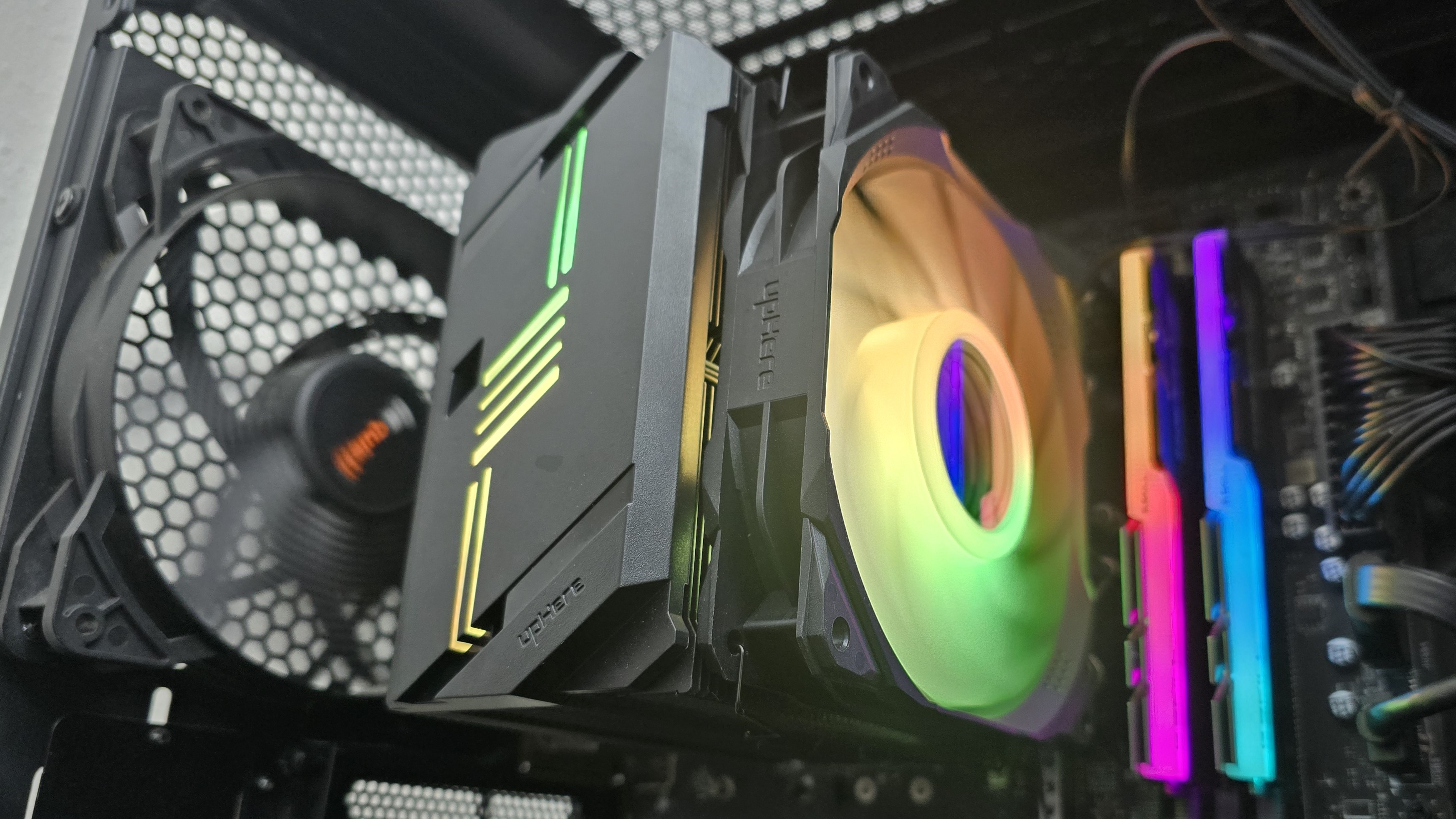Tom's Hardware Verdict
For less than $20 USD, UpHere’s C5C offers essential cooling performance and low noise levels for your CPU.
Pros
- +
Low price of under $20 for the C5C Model
- +
Low noise levels for the C5C Model
- +
D6SEC model can be installed without removing fans
Cons
- -
D6SEC doesn’t stand out from the competition, and it’s noisy
Why you can trust Tom's Hardware
Not every brand can be a household name, but today we’re testing a couple of coolers from UpHere, a brand that I recently discovered while shopping on Amazon. It was difficult to find information about them, as the company doesn’t maintain an English-language website. UpHere is a daughter brand of Dongguan Duban Electronic Commerce Co., Ltd., and appears to have been founded in 2016. UpHere primarily focuses on cooling solutions for the mainland China market, but its products are also widely available on Amazon and Newegg.
Today we’ll be reviewing two of UpHere’s budget air coolers, the C5C and D6SEC. Both of these coolers feature direct touch heatpipes, but what really makes them stand out is price: The C5C costs less than $20 USD! With such a low price, one has to wonder if the cooler is actually strong enough to tame a hot CPU like Intel’s i7-13700K. Does UpHere have what it takes to earn a spot on our best air coolers list? We’ll have to put its coolers through testing to find out. But first, here are the specifications from UpHere.
Cooler specifications
| Cooler | UpHere D6SEC | UpHere C5C |
| MSRP | $35.99 USD | $16.99 USD |
| Heatsink Material | Aluminum | Aluminum |
| Rated Lifespan | Unlisted | Unlisted |
| Socket Compatibility | Intel Socket LGA 1851/1700/1200/115x/20xx/13xx AMD AM5/AM4/AM3(+)/AM2(+) / FM1/FM2 | Intel Socket LGA 1851/1700/1200/115x/20xx/13xx AMD AM5/AM4/AM3(+)/AM2(+) / FM1/FM2 |
| Base | Direct Touch Copper Heatpipes | Direct Touch Copper Heatpipes |
| Max TDP (Our Testing) | ~219W with Intel’s i7-13700K | ~183W with Intel’s i7-13700K |
| Installed Size (with fans) | 125mm (L) x 125 mm (W) x 154mm (D) | 124 (L) x 76 mm (W) x 155mm (D) |
| Warranty | Not specified | Not specified |
Packing and included contents
The packaging of these coolers is fairly standard, with molded foam and plastic coverings to protect the contents during shipping.
Included with the cooler are the following:
- Heatsinks
- Fans
- Mounting for modern AMD and Intel Platforms
- Thermal Paste
Features of UpHere’s Air Coolers
▶ Direct Touch Heatpipes
What initially caught my eye is that these coolers have five (C5C model) or six (D6SEC model) direct-touch heatpipes. Most units that feature direct-touch heatpipes are limited to four or less. To fit six of these on the D6SEC model, the heatpipes are slightly smaller.
▶ Low Pricing
Get Tom's Hardware's best news and in-depth reviews, straight to your inbox.
Both of these coolers are quite affordable. The D6SEC model runs for $35 USD, and the C5C is even cheaper at only $17 USD.
▶ Install without removing the fans (D6SEC model only)
The D6SEC model has indentions in the first heatsink tower, which allows you to slide a screwdriver through it to install the cooler without needing to remove its fans. This saves a few minutes during installation, and I imagine this would be considered most useful for those who build custom PCs.
▶ Full RAM Compatibility
Neither model of UpHere’s air coolers interferes or overhangs DIMM slots in any manner, which means you can use these coolers no matter how short or tall your computer’s RAM is.
▶ Heatsink design
The D6SEC has a fairly standard heatsink design, with 3 indentations.
The C5C’s heatsink has alternating, staggered indentations along the exit. These types of designs are intended to help improve the static pressure of airflow.
▶ Included Thermal Paste
UpHere includes a small 1g tube of thermal paste with each cooler. The paste is rated for 14.3 w/mK
▶ 120mm fans
There’s not much to say about the included fans, but it’s worth noting that the fan included with the C5C features ARGB lighting and an infinity mirror.
| Model | D6SEC Cooler fans | C5C Cooler fan |
| Dimensions | 120 x 120 x 25mm | 120 x 120 x 25mm |
| Fan Speed | 600-1600 RPM ± 10% | 800-1800 RPM ± 10% |
| Air Flow | Up to 68.2 CFM | Up to 79.18 CFM |
| Air Pressure | Up to 1.55 mmH2O | Unlisted |
| Bearing Type | Hydraulic Bearing | Hydraulic Bearing |
| Lighting | None | ARGB |
| MFFT | Unlisted | Unlisted |
LGA1700 Socket Bending
Many factors other than the CPU cooler can influence your cooling performance, including the case you use and the fans installed in it. A system's motherboard can also influence this, especially if it suffers from bending, which results in poor cooler contact with the CPU.
In order to prevent bending from impacting our cooling results, we’ve installed Thermalright’s LGA 1700 contact frame into our testing rig. If your motherboard is affected by bending, your thermal results will be worse than those shown below. Not all motherboards are affected equally by this issue. I tested Raptor Lake CPUs in two motherboards. And while one of them showed significant thermal improvements after installing Thermalright’s LGA1700 contact frame, the other motherboard showed no difference in temperatures whatsoever! Check out our review of the contact frame for more information.
Testing Methodology, and how my testing differs vs the competition
My cooler testing is specifically designed to emulate the conditions a user would actually experience when using a computer. Some reviewers test coolers using an open bench. I do not like this method, it reduces cooling difficulty. When you use a case, the internal temperature of that case will become higher than that of the room’s ambient temperature, increasing the saturation of the cooler and overall cooling difficulty. Testing outside of a case will give an advantage to weaker coolers, especially those with fans that aren’t very strong.
Others test using a thermal heatplate. This method suffers from all the drawbacks of an open bench, but also doesn’t accurately represent cooling a CPU. A thermal plate evenly distributes a thermal load across the copper heat conduction square. The problem with this type of testing is that modern AMD Ryzen and Intel Core CPUs have most of their heat concentrated in a few hotspots – and cooling a concentrated source of heat is more difficult than cooling a source that’s spread evenly.
In discussions with industry representatives, one manufacturer (who wishes to remain anonymous) mentioned that in the past they once used heat plates in a thermal chamber during their design process, until they realized that method of testing was “giving us nice TDP numbers to print on the box, but is not reflective of the user experience at all.” They mentioned that switching to tests using real CPUs increased their testing time, but also provided valuable data to help improve their products. An example they provided is that this testing allowed them to properly observe “differences between AMD and Intel systems, which we can then address.”
The last thing I do differently from some cooler testers is that I insist on using relatively new CPUs for cooler testing because people building new PCs should be using recent CPUs. Also, thermal density is just different with newer CPUs. Products like Ryzen 3000 “Zen 2” and older 14nm Intel CPUs have lower heat density compared to modern counterparts, due to a combination of using older manufacturing processes and running at lower clock speeds. Using a weaker cooler with an older CPU can make the cooler look better performing than it actually is with current-gen silicon.
Today's highest-end CPUs, whether Intel or AMD, are difficult to cool in intensive workloads. In the past. reaching 95 degrees Celsius or more on a desktop CPU might have been a cause for concern. But with today’s top-end CPUs, this is considered normal operation. Similar behavior has been present in laptops for years due to cooling limitations in tight spaces.
All testing is performed with a 23C ambient room temperature. Multiple thermal tests are run on each CPU to test the cooler in a variety of conditions, and acoustic measurements are taken with each result. These tests include:
1. Noise-normalized testing at low noise levels
2. “Out-of-the-box”/Default configuration thermal and acoustic testing
a. No power limits enforced
b. Because CPUs hit TJ Max in this scenario, the best way to compare cooling strength is by recording the total CPU package power consumption.
3. Thermal and acoustic testing in power-limited scenarios
a. Power limited to 175W to emulate a medium-intensity workload
b. Power limited to 125W to emulate a low-intensity workload
The thermal results included are for 10-minute testing runs. To be sure that was sufficiently long to tax the cooler, we tested both Thermalright’s Assassin X 120 R SE and DeepCool’s LT720 with a 30-minute Cinebench test with Intel’s i9-13900K for both 10 minutes and 30 minutes. The results didn’t change much at all with the longer test: The average clock speeds maintained dropped by 29 MHz on DeepCool’s LT720 and 31 MHz on Thermalright’s Assassin X 120 R SE. That’s an incredibly small 0.6% difference in clock speeds maintained, a margin of error difference that tells us that the 10-minute tests are indeed long enough to properly test the coolers.
Testing configuration – Intel LGA1700 platform

Albert Thomas is a contributor for Tom’s Hardware, primarily covering CPU cooling reviews.
-
Misgar Amazon's price for the C5C in the UK is £24.16 equivalent to US $30.92 and the D6SEC is £45.14 (US $57.77).Reply
Contrast these UK prices to those in the USA of $16.99 and $35.99 and you'll see Amazon UK's prices are hugely inflated, possibly due to economies of scale? I don't expect Amazon will sell many of these coolers in the UK.
I think I'll stick to the Thermalright Peerless Assassin 120SE in my cheaper builds and Noctua NH-D15 for my main systems.










